Cottage industry definition: a small-scale, decentralised manufacturing business that’s generally operated out of a home (hence: cottage) and often producing labour-intensive products. These products usually face intense competition from large-scale manufacturers.
I like lace (who doesn’t?) but I have to admit that I know next to nothing about it. My wedding dress was made of vintage Parisian lace and while it was beautiful I couldn’t have told you what made the lace “Parisian”.
On a mission to understand one of Ireland’s most intricate cottage industries, I implore Mary O’Neill – a lacemaker from Tullow, Co Carlow who has been making lace in the Carrickmacross style for 45 years – to tell me everything she knows about the history of lace in Ireland and its importance to Irish craft-making.
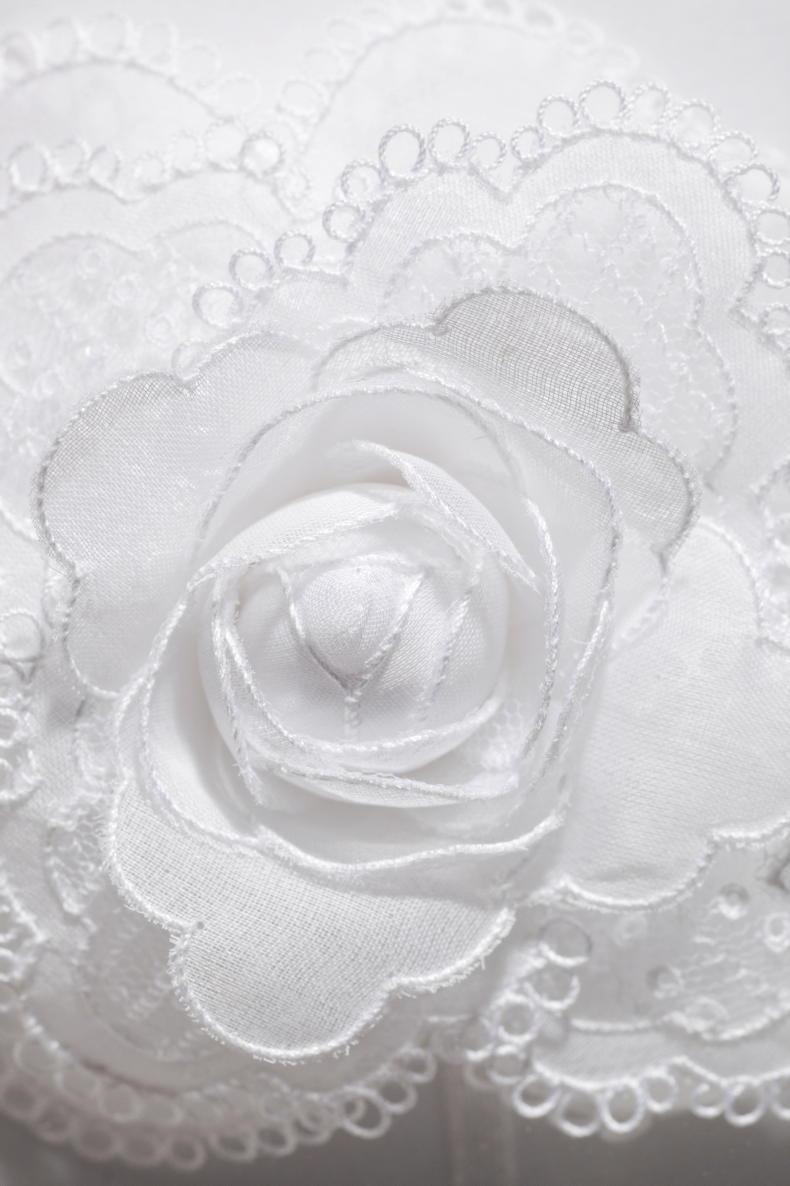
Mary won the Branchardière Lace Award in 2010 for Soineantacht; a three-dimensional white rose made of Carrickmacross lace.
The request flusters her a bit and by the time we’re finished speaking I understand why: it’s impossible to learn about Irish lacemaking in an hour-long interview. There are too many styles, each with their own distinctive stories and histories. There are varying opinions from experts as to what constitutes a particular lace style, or even lace in general, and it can be easy to cause offense within lace-making circles.
Suddenly, writing about Irish lace is making me a bit nervous.
Lifetime of lace
But Mary puts me at ease. Her easy-going manner and obvious love for lacemaking enables our conversation to flow. She recalls how she got into Carrickmacross lacemaking at the age of 12. 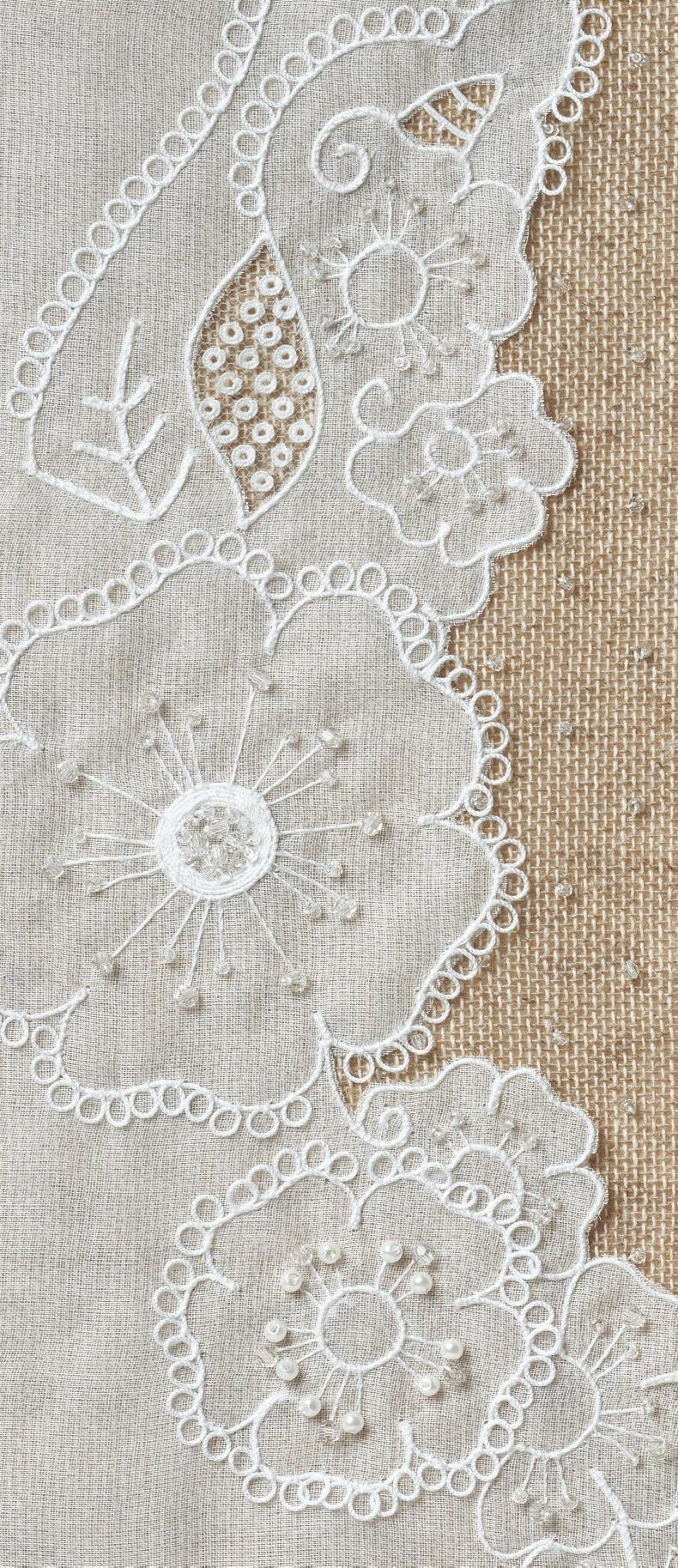
“I am self-taught, really,” she explains. “I first learned how to make the lace when I was 12 years of age in a classroom situation. It was difficult to learn but I persisted and over the next five years I made Carrickmacross lace for Sister Paschal Richardson (from the Brigidine Convent in Tullow) who originally taught me.
“So I was making lace for her and she was selling it in Dublin,” she continues. “I was making maybe two or three pounds [for my work] at the time, which was a lot of money, so I was delighted.”
Mary made and sold lace throughout secondary school. When she graduated, she moved to France for work. Finding herself with some time on her hands – and with a new appreciation of home you only really acquire when you move away – she once again started making lace as a hobby.
She lived in France for seven years; first employed as an au pair and then working in a hotel in Lourdes. After France she moved to London where she continued her lacemaking hobby. After an additional seven years in England, Mary felt the pull to come home and start her own business.
Setting down roots
Though a Carlow native, Mary had friends (from her time in France) living in Tralee. She decided to move there to begin a business appraisal course.
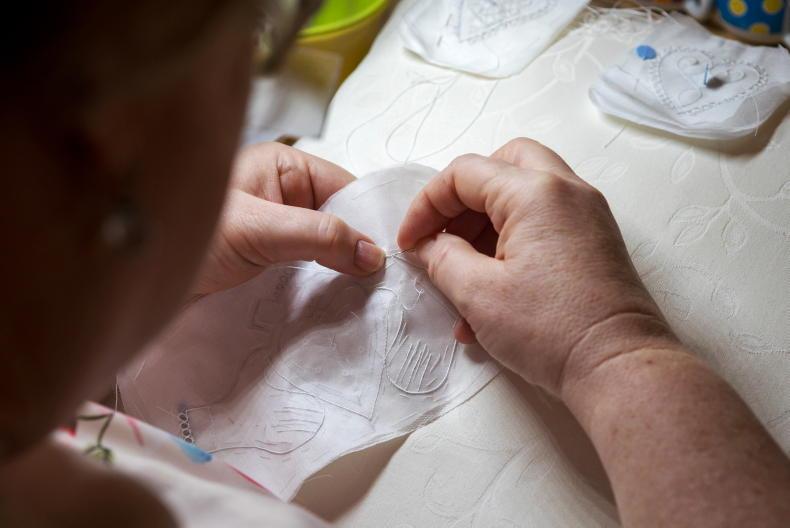
Carrickmacross lace dates back to around 1820. \ Claire Nash
“Then I ended up in Ballinskelligs in Kerry,” she says. “I was on a course for six months, which brought me to the famine village there. I fell in love with the place so I set up a little business (Ardúin Lace Collection) there in 1998.”
In 2003, Mary relocated to Tullow and renamed her business The Lace Gallery (thelacegallery.com). She sells lace products and has authored two books on lacemaking (Carrickmacross Lace… The Lace with a Twist 1 & 2) and has a third book on the way (Irish Lace and Lacemakers) which will focus on groups and individual lacemakers sharing their stories.
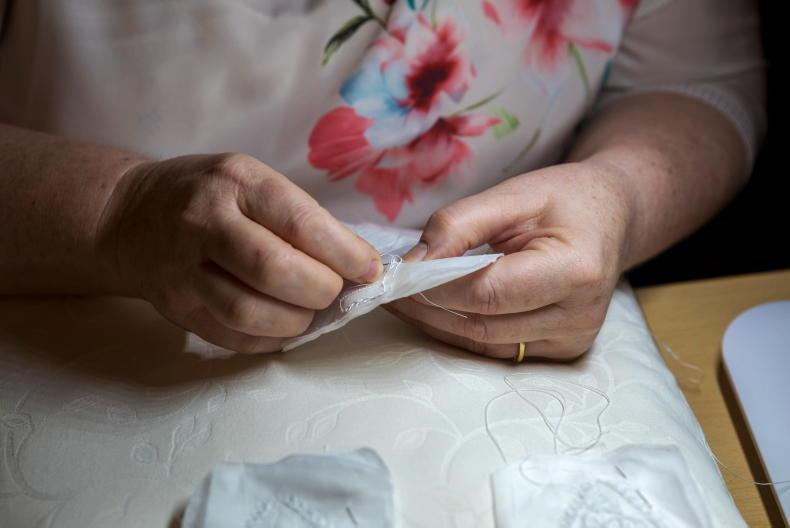
In both 2008 and 2010 she was the proud recipient of the Eleanor de la Branchardière Lace Award, which recognises innovative design in lacemaking.
“I made the two winning pieces using the Carrickmacross Lace technique,” she says, describing her wins. “I created Bláthanna Lása (2008) using various flower designs associated with Carrickmacross Lace with the addition of Swarovski crystals. The piece was then mounted onto Hessian. Soineantacht (2010) is a three-dimensional white rose. It remains one of my favourite pieces. Winning such a prestigious award inspired and encouraged me. It developed my self-belief as both a designer and lacemaker.”
All about technique
Irish Country Living asks Mary what differentiates types of regional Irish lace? There’s Carrickmacross lace, Limerick lace, Kenmare lace – is it a specific style or more the materials used which differ?
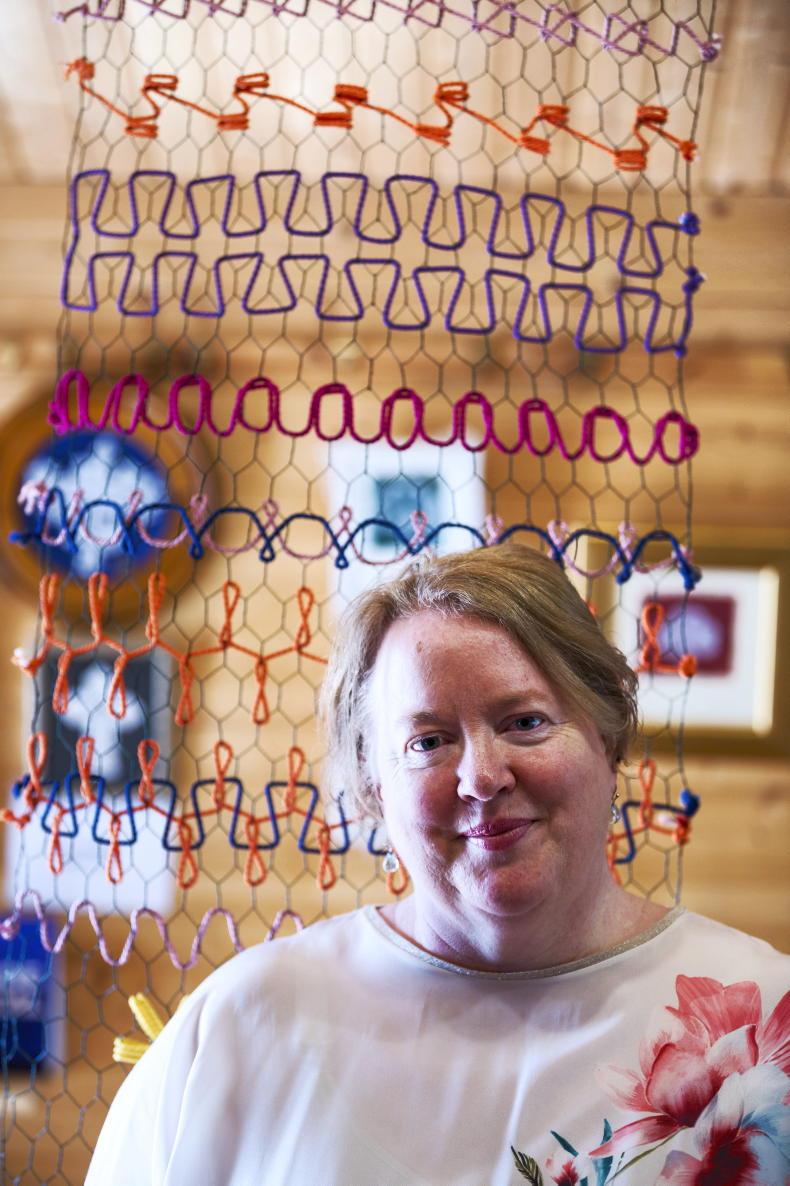
Mary got into lacemaking at the age of 12. \ Claire Nash
“It’s technique, really,” she explains. “Living in Carlow, there’s Borris lace (Borris is a little village in south Co Carlow). For Borris, they do a tape lace – a machine-made tape which draws out a pattern and then it’s filled in with stitches. In Carrickmacross lace, you use several layers of material and you need a looped edge and pops – those are two characteristics for Carrickmacross lace.”
Differing opinions
So, how many different types of Irish heritage lace are there? For her third book, Mary has put considerable research into answering this question – but she says it’s not an easy one to answer.
“It’s a delicate subject,” She laughs.
“I’ve contacted most of the groups in Ireland that would make lace and I now have 14 techniques in that list. [That said], you will sometimes get the traditionalist who will say: ‘That’s not real lace.’”
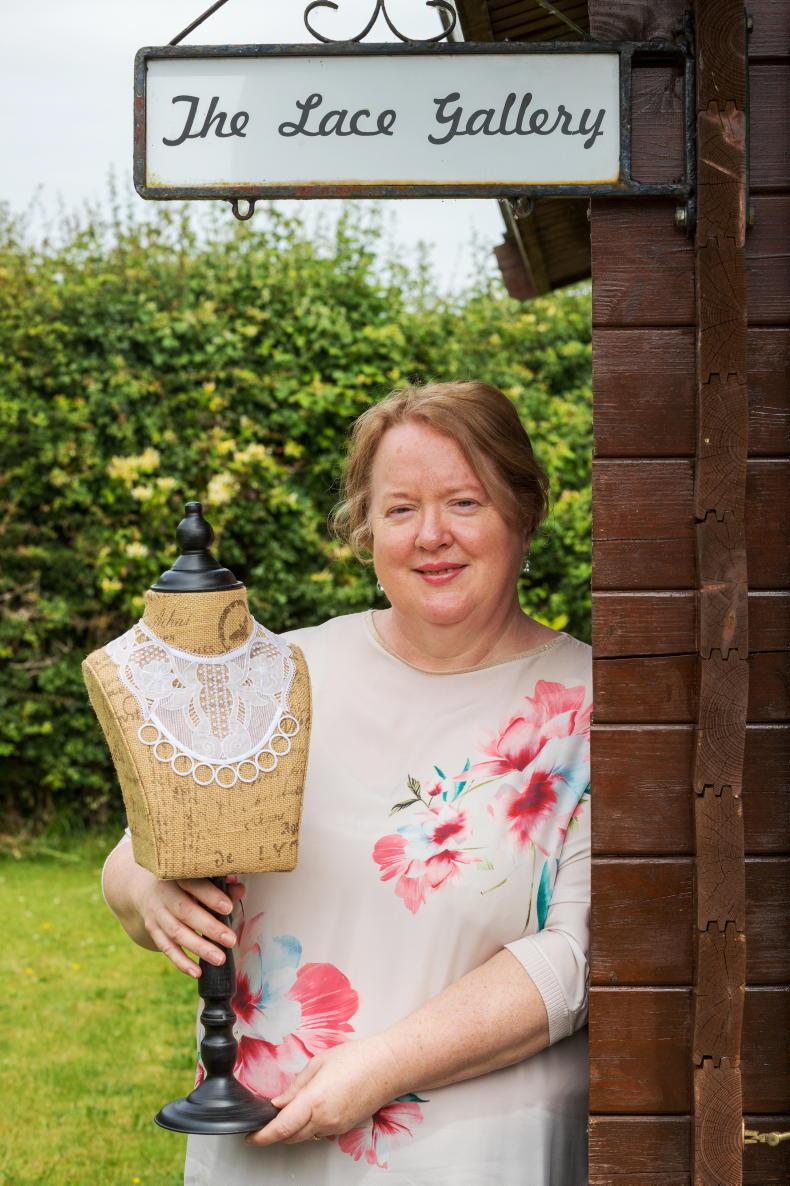
In 2008 and 2010, Mary won the Branchardière Lace Award, which recognises innovative design in lacemaking. \ Claire Nash
Mary also says, although there are types of Irish lace connected to particular locations, you don’t have to be from a place – or even living there – to practise that type of lacemaking. This makes sense when you consider her speciality, Carrickmacross lace, is from Co Monaghan.
“For example, Irish crochet lace is associated with Cork and Kilcullen (in Co Kildare), but you’ll find it all over Ireland. The same goes for Limerick lace – it’s not confined to Limerick.”
Royal fanfare
It was widely reported that when Kate Middleton married Prince William in 2011 her dress contained Carrickmacross lace. This delighted lacemakers throughout Ireland but apparently it wasn’t Carrickmacross lace at all.
“At first, I actually believed it,” she laughs. “But what she had were motifs which were stitched on to a background material using the same technique as Carrickmacross. The day she got married and it was announced, I’d say I got 150 emails instantly! It’s amazing how that happens.”
Cottage Industry

Lacemaking is one of Ireland’s historic cottage industries – in some instances, dating back to over 250 years. Mary says Carrickmacross lace, while not well-documented, can be traced back to around 1820.
“It’s a hobby for most people today and it’s generally the older generations you’ll find making lace,” she says. “It’s mostly the older person who is retired and now has the time or maybe they were taught earlier and have more time to do it.
“I know with the Borris lacemakers they are visiting schools to try and introduce the lace locally at least. So that’s good.”
In July 2019, Minister for Culture, Heritage and the Gaeltacht Josepha Madigan TD launched the permanent National Inventory of Intangible Cultural Heritage, celebrating living cultural heritage practices in Ireland. This measure represents official State recognition of cultural practices all around Ireland and included in the practices were Limerick Lace, Irish Crochet Lace and Carrickmacross Lace.
“I have huge respect for traditional lacemakers and lace historians who have documented the heritage of lace,” Mary says. “At the end of the day, I am not claiming to be anything but a lacemaker who loves to design and make lace.” CL
Limerick Lace: Dates back to 1829. It’s a “mixed lace” rather than a “true lace” (a true lace being entirely made by hand). Famously worn by Queen Victoria and Eleanor Roosevelt.
Carrickmacross Lace: General consensus is this lace dates back to around 1820. It uses a multi-layer approach, with the design being stitched on to machine-made net.
Kenmare Lace: Dates back to the 1860s. Kenmare Lace is made entirely by hand with a needle and thread and, as it is time consuming to make, is very expensive.
Irish Crochet Lace: Dates back to the mid-1800s in counties Cork and Kildare. This lace is made of separately crocheted motifs which are then fixed on to a mesh background.
In the 1800s, most lacemaking was done by young girls. They would be taught by nuns in an attempt to give them a profitable skillset. Indeed, the lacemaking turned out to be a successful way to supplement their household income.
The Headford
Lace Project
A group of enterprising women from Headford, Co Galway, are reviving the almost-lost art of Headford Lace as part of a community development programme.
The Headford Lace Project incorporates educational workshops, lessons in lacemaking and art exhibitions to help celebrate and preserve the history of Headford Lace, which is over 250 years old.
“We reckon it goes back a bit further but, yes, 250 years it’s been going and, more recently, revived,” says Headford Lace Project committee member Kathleen McMahon.
The committee is made up of a diverse group of community members, including artists, archivists, historians, educators and craftspeople. One exciting aspect of the project is the current attempt by a group of community members to grow their own flax, which will hopefully then be spun into linen and, eventually, be made into Headford Lace.
“Flax used to be grown all over this part of the country for linen,” Kathleen says, “so it’s exciting to be doing this once again.”
There has been a lot of positive support for the project, both from within the community and internationally.
“It’s part of women’s history,” Kathleen explains. “Often with the women who made the lace their occupation wasn’t documented – just those of their husbands. We know historically of six lacemakers from the area and it’s important to revive this part of our heritage and culture.”
Headford Lace is a bobbin-style lace (similar to weaving); the only such style in Ireland discovered so far (though it’s possible there are other Irish bobbin-styles out there). Kathleen says it was very nearly lost and they have been astounded by how much they have learned about the lace since the inception of their project. It has received renewed interested by the younger members of the community.
“Our youngest lacemaker started at six and she’s now ten – a lot of the people we have in our workshops are in their 20s to 40s. We’re reaching lots of younger people,” Kathleen says.
To learn more about the project, visit headfordlaceproject.ie. For those interested in the flax-growing project, the group can be found on Facebook (Headford Flax Growers).
Cottage industry definition: a small-scale, decentralised manufacturing business that’s generally operated out of a home (hence: cottage) and often producing labour-intensive products. These products usually face intense competition from large-scale manufacturers.
I like lace (who doesn’t?) but I have to admit that I know next to nothing about it. My wedding dress was made of vintage Parisian lace and while it was beautiful I couldn’t have told you what made the lace “Parisian”.
On a mission to understand one of Ireland’s most intricate cottage industries, I implore Mary O’Neill – a lacemaker from Tullow, Co Carlow who has been making lace in the Carrickmacross style for 45 years – to tell me everything she knows about the history of lace in Ireland and its importance to Irish craft-making.

Mary won the Branchardière Lace Award in 2010 for Soineantacht; a three-dimensional white rose made of Carrickmacross lace.
The request flusters her a bit and by the time we’re finished speaking I understand why: it’s impossible to learn about Irish lacemaking in an hour-long interview. There are too many styles, each with their own distinctive stories and histories. There are varying opinions from experts as to what constitutes a particular lace style, or even lace in general, and it can be easy to cause offense within lace-making circles.
Suddenly, writing about Irish lace is making me a bit nervous.
Lifetime of lace
But Mary puts me at ease. Her easy-going manner and obvious love for lacemaking enables our conversation to flow. She recalls how she got into Carrickmacross lacemaking at the age of 12. 
“I am self-taught, really,” she explains. “I first learned how to make the lace when I was 12 years of age in a classroom situation. It was difficult to learn but I persisted and over the next five years I made Carrickmacross lace for Sister Paschal Richardson (from the Brigidine Convent in Tullow) who originally taught me.
“So I was making lace for her and she was selling it in Dublin,” she continues. “I was making maybe two or three pounds [for my work] at the time, which was a lot of money, so I was delighted.”
Mary made and sold lace throughout secondary school. When she graduated, she moved to France for work. Finding herself with some time on her hands – and with a new appreciation of home you only really acquire when you move away – she once again started making lace as a hobby.
She lived in France for seven years; first employed as an au pair and then working in a hotel in Lourdes. After France she moved to London where she continued her lacemaking hobby. After an additional seven years in England, Mary felt the pull to come home and start her own business.
Setting down roots
Though a Carlow native, Mary had friends (from her time in France) living in Tralee. She decided to move there to begin a business appraisal course.

Carrickmacross lace dates back to around 1820. \ Claire Nash
“Then I ended up in Ballinskelligs in Kerry,” she says. “I was on a course for six months, which brought me to the famine village there. I fell in love with the place so I set up a little business (Ardúin Lace Collection) there in 1998.”
In 2003, Mary relocated to Tullow and renamed her business The Lace Gallery (thelacegallery.com). She sells lace products and has authored two books on lacemaking (Carrickmacross Lace… The Lace with a Twist 1 & 2) and has a third book on the way (Irish Lace and Lacemakers) which will focus on groups and individual lacemakers sharing their stories.

In both 2008 and 2010 she was the proud recipient of the Eleanor de la Branchardière Lace Award, which recognises innovative design in lacemaking.
“I made the two winning pieces using the Carrickmacross Lace technique,” she says, describing her wins. “I created Bláthanna Lása (2008) using various flower designs associated with Carrickmacross Lace with the addition of Swarovski crystals. The piece was then mounted onto Hessian. Soineantacht (2010) is a three-dimensional white rose. It remains one of my favourite pieces. Winning such a prestigious award inspired and encouraged me. It developed my self-belief as both a designer and lacemaker.”
All about technique
Irish Country Living asks Mary what differentiates types of regional Irish lace? There’s Carrickmacross lace, Limerick lace, Kenmare lace – is it a specific style or more the materials used which differ?

Mary got into lacemaking at the age of 12. \ Claire Nash
“It’s technique, really,” she explains. “Living in Carlow, there’s Borris lace (Borris is a little village in south Co Carlow). For Borris, they do a tape lace – a machine-made tape which draws out a pattern and then it’s filled in with stitches. In Carrickmacross lace, you use several layers of material and you need a looped edge and pops – those are two characteristics for Carrickmacross lace.”
Differing opinions
So, how many different types of Irish heritage lace are there? For her third book, Mary has put considerable research into answering this question – but she says it’s not an easy one to answer.
“It’s a delicate subject,” She laughs.
“I’ve contacted most of the groups in Ireland that would make lace and I now have 14 techniques in that list. [That said], you will sometimes get the traditionalist who will say: ‘That’s not real lace.’”

In 2008 and 2010, Mary won the Branchardière Lace Award, which recognises innovative design in lacemaking. \ Claire Nash
Mary also says, although there are types of Irish lace connected to particular locations, you don’t have to be from a place – or even living there – to practise that type of lacemaking. This makes sense when you consider her speciality, Carrickmacross lace, is from Co Monaghan.
“For example, Irish crochet lace is associated with Cork and Kilcullen (in Co Kildare), but you’ll find it all over Ireland. The same goes for Limerick lace – it’s not confined to Limerick.”
Royal fanfare
It was widely reported that when Kate Middleton married Prince William in 2011 her dress contained Carrickmacross lace. This delighted lacemakers throughout Ireland but apparently it wasn’t Carrickmacross lace at all.
“At first, I actually believed it,” she laughs. “But what she had were motifs which were stitched on to a background material using the same technique as Carrickmacross. The day she got married and it was announced, I’d say I got 150 emails instantly! It’s amazing how that happens.”
Cottage Industry

Lacemaking is one of Ireland’s historic cottage industries – in some instances, dating back to over 250 years. Mary says Carrickmacross lace, while not well-documented, can be traced back to around 1820.
“It’s a hobby for most people today and it’s generally the older generations you’ll find making lace,” she says. “It’s mostly the older person who is retired and now has the time or maybe they were taught earlier and have more time to do it.
“I know with the Borris lacemakers they are visiting schools to try and introduce the lace locally at least. So that’s good.”
In July 2019, Minister for Culture, Heritage and the Gaeltacht Josepha Madigan TD launched the permanent National Inventory of Intangible Cultural Heritage, celebrating living cultural heritage practices in Ireland. This measure represents official State recognition of cultural practices all around Ireland and included in the practices were Limerick Lace, Irish Crochet Lace and Carrickmacross Lace.
“I have huge respect for traditional lacemakers and lace historians who have documented the heritage of lace,” Mary says. “At the end of the day, I am not claiming to be anything but a lacemaker who loves to design and make lace.” CL
Limerick Lace: Dates back to 1829. It’s a “mixed lace” rather than a “true lace” (a true lace being entirely made by hand). Famously worn by Queen Victoria and Eleanor Roosevelt.
Carrickmacross Lace: General consensus is this lace dates back to around 1820. It uses a multi-layer approach, with the design being stitched on to machine-made net.
Kenmare Lace: Dates back to the 1860s. Kenmare Lace is made entirely by hand with a needle and thread and, as it is time consuming to make, is very expensive.
Irish Crochet Lace: Dates back to the mid-1800s in counties Cork and Kildare. This lace is made of separately crocheted motifs which are then fixed on to a mesh background.
In the 1800s, most lacemaking was done by young girls. They would be taught by nuns in an attempt to give them a profitable skillset. Indeed, the lacemaking turned out to be a successful way to supplement their household income.
The Headford
Lace Project
A group of enterprising women from Headford, Co Galway, are reviving the almost-lost art of Headford Lace as part of a community development programme.
The Headford Lace Project incorporates educational workshops, lessons in lacemaking and art exhibitions to help celebrate and preserve the history of Headford Lace, which is over 250 years old.
“We reckon it goes back a bit further but, yes, 250 years it’s been going and, more recently, revived,” says Headford Lace Project committee member Kathleen McMahon.
The committee is made up of a diverse group of community members, including artists, archivists, historians, educators and craftspeople. One exciting aspect of the project is the current attempt by a group of community members to grow their own flax, which will hopefully then be spun into linen and, eventually, be made into Headford Lace.
“Flax used to be grown all over this part of the country for linen,” Kathleen says, “so it’s exciting to be doing this once again.”
There has been a lot of positive support for the project, both from within the community and internationally.
“It’s part of women’s history,” Kathleen explains. “Often with the women who made the lace their occupation wasn’t documented – just those of their husbands. We know historically of six lacemakers from the area and it’s important to revive this part of our heritage and culture.”
Headford Lace is a bobbin-style lace (similar to weaving); the only such style in Ireland discovered so far (though it’s possible there are other Irish bobbin-styles out there). Kathleen says it was very nearly lost and they have been astounded by how much they have learned about the lace since the inception of their project. It has received renewed interested by the younger members of the community.
“Our youngest lacemaker started at six and she’s now ten – a lot of the people we have in our workshops are in their 20s to 40s. We’re reaching lots of younger people,” Kathleen says.
To learn more about the project, visit headfordlaceproject.ie. For those interested in the flax-growing project, the group can be found on Facebook (Headford Flax Growers).








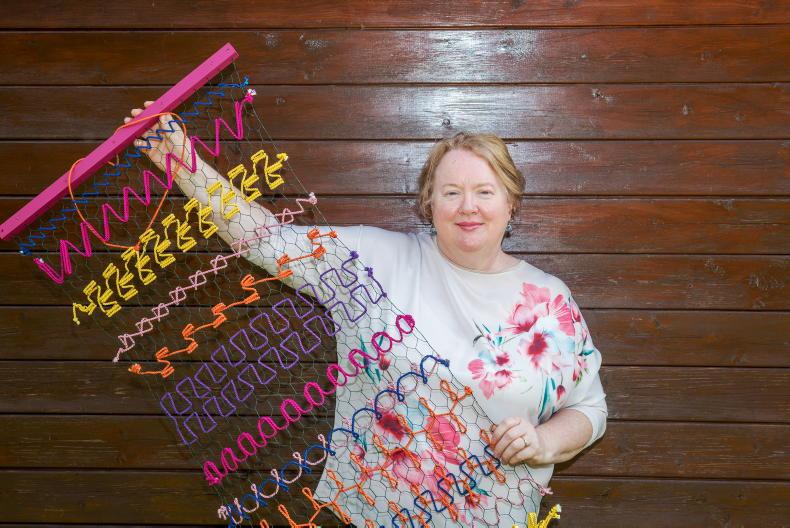




 This is a subscriber-only article
This is a subscriber-only article









SHARING OPTIONS: